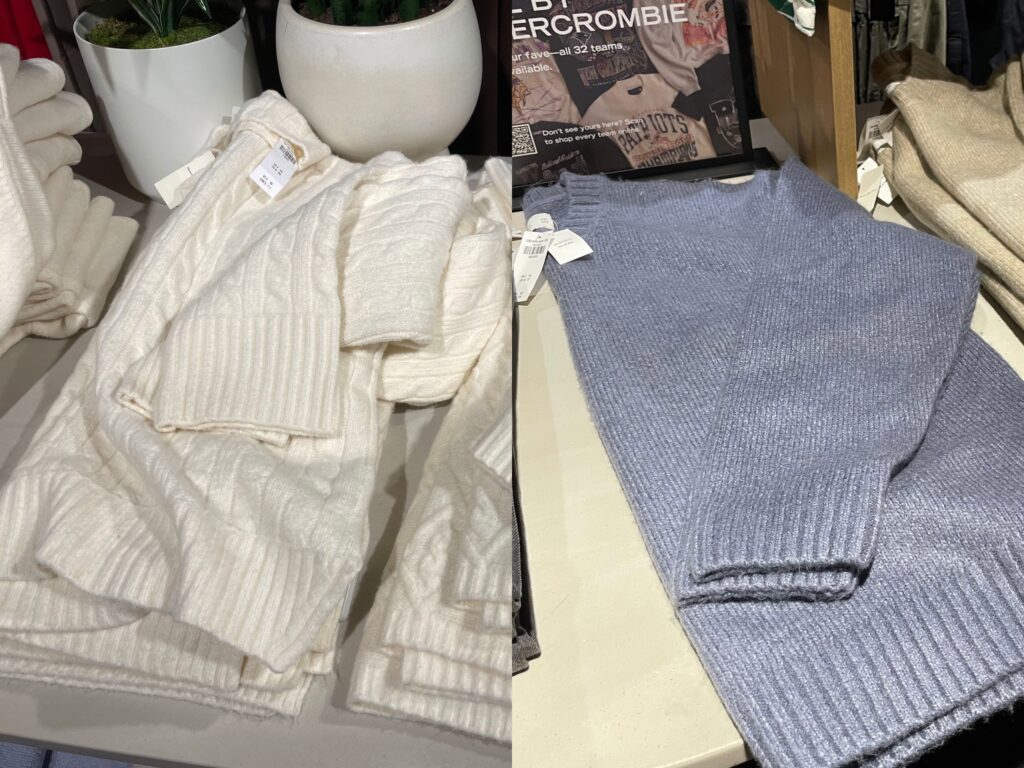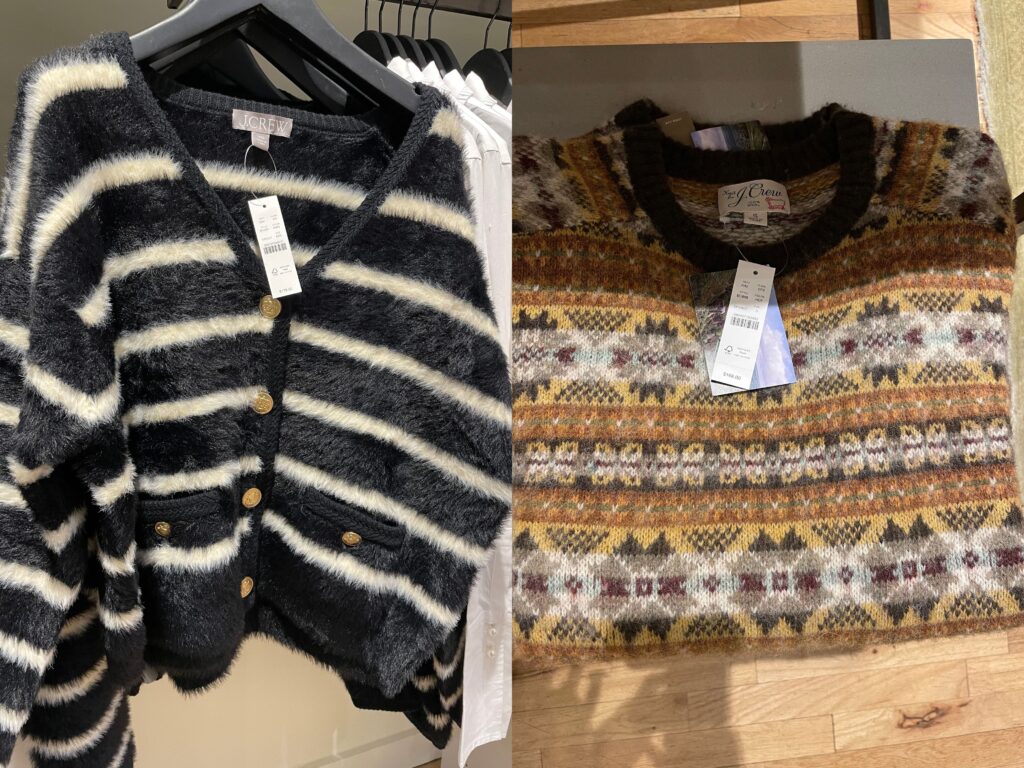- Women's sweaters can be more expensive than men's sweaters.
- This has to do with costs like tariffs and discounts that factor into the retail price.
- Brands often add synthetic fibers to women's sweaters to make them less expensive.
Emily Bello will be shopping for sweaters in the men's section.
Bello recently posted a video lamenting the quality and high prices of the women's sweaters she's been seeing online and in-store.
There are several reasons brands do jack up prices and substitute natural fabrics like wool for synthetic fibers in women's clothing. The rationale has a lot to do with perceived differences between how men and women typically shop.
For example, while browsing Nordstrom's site she noticed a women's sweater and a men's sweater from the same brand priced at $170. Though they cost the same, the men's sweater was 100% wool and the women's sweater was a wool blend, which means synthetic materials like polyester, acrylic, or nylon are mixed in with the wool.
@emilywantsflowers Welcome to my ramblings about sweaters!! If youre new to my corner of TikTok im on a journey to fill my wardrobe with nearly exclusively natural fibers (thoughtfully and very slowly of course). Sweaters can completely change how winter effects us. When Im warm, im happy lol #woolsweaters #personalstyle #sweaterweather #highlowfashion #llbeansweater #winterstyletips #cashmeresweater #deinfluencing #deinfluencingfastfashion #emilybello #greenscreen
Bello, 24, doesn't call herself a fashion expert, just someone who likes to shop and share her hobby with her 16,900 followers. In college, she stopped buying cheap, single-wear items in favor of pieces that would last.
"Most of all, I just like to have things in my home and in my closet that I love and cherish," she told Business Insider. "That can be kind of expensive if your clothes are constantly falling apart."
Now she looks for high-quality sweaters that will keep her warm during Chicago winters. "I'm very into sweaters," she said.
Business Insider spoke to experts to understand why women's sweaters can be more expensive than men's sweaters.
Deeper discounts
Sheng Lu is an associate professor of fashion and apparel studies at the University of Delaware. He teaches courses that focus on product sourcing and pricing practices.
He told BI that companies typically set their prices based on the cost of goods, expected gross margin, and retail reduction, or the discount they expect to offer in the future. Women's apparel is more trend-driven than menswear and has a more competitive market. These factors can pressure retailers to heavily discount women's clothing, Lu explained.
"They anticipate more discounts you have to offer during the selling season, therefore, they price their products higher," he said.
With the changing trends, women's apparel can also be riskier to sell. "There can be some risk involved in predicting what consumers may want," Lu said. If those predictions are wrong, retailers are stuck with unsold inventory, so they factor this risk into the retail price.
Higher tariffs
Most of the clothing we see in stores today is imported from other countries, Lu said. That means tariffs, or import taxes, can also affect the retail price.
Lu pulled import data for this story from the US Department of Commerce and the US International Trade Commission. He noticed some tariff prices were higher for women's apparel than for men's, though it didn't appear to be systematic, he said.
According to 2022 ITC data, several categories had the same tariffs for both men's and women's clothing, while others did not. For example, men's wool sweaters had an average tariff rate of 13.6%, while women's wool sweaters had an average tariff rate of 14.9%.

"For some commonly worn clothing, the tariff rate for womenswear is relatively higher than menswear," Lu said. "Which means even if you import the same item, pay the same price, for womenswear you have to pay a higher tariff. And surely retailers will pass over these tariffs to consumers."
One reason for the discrepancy could be because womenswear is more frequently imported from Asian countries where tariffs are required, Lu said. Companies can avoid tariffs when they import from countries where the US has free-trade agreements, such as Mexico and Canada.
More complex designs
But it's not just the import country that affects tariffs. Rates are also determined by the material content and style details of a garment.
Fran Kozen is a fiber science and apparel design professor at Cornell University. She told BI that since women's styles are usually more complex than men's they can garner higher tariff rates.
"The embellishments and things that are put onto women's tops, for instance, mean that the tariffs are higher on those than on a plain T-shirt," Kozen said.

This also translates to the overall cost of manufacturing the garment. Women's apparel follows rapidly changing trend cycles and typically offers a wider range of sizes and colors.
"That costs brands more money every time they have to develop a new product," Kozen said.
It can also be more difficult to design women's garments for a variety of sizes, so product development can take longer, she added.

More synthetic fibers
When it comes to materials, women's sweaters are often blended with both natural and synthetic materials to fit their preferences.
"Women like drapey, closer to the body fitting things," Kozen said. "Lighter weight sweaters are going to be appealing." While natural fibers like cotton and wool can be stiff, synthetic fibers add softness. Men's sweaters can also contain synthetic fibers like polyester, she said, but it's usually for durability and strength.
Synthetic fibers also make it possible for retailers to keep prices low, she added — an expectation many customers have if they shop frequently and keep up with the latest trends.

It can be difficult to find high-quality sweaters when shopping online, so Bello recommends shopping by item rather than brand. She typically looks for sweaters with 70% to 85% natural fibers in classic styles that won't go out of fashion.
"I prefer materials that are thicker, so they'll look more starchy in the photo," she said. "But if something looks super breezy, you can kind of tell that it's thinner material."
Beyond that, she suggests getting something "that you think you'll love for years to come," she said. And if it's not right, return it.
"If it doesn't live up to what you're imagining, then you're not going to reach for it as often."
